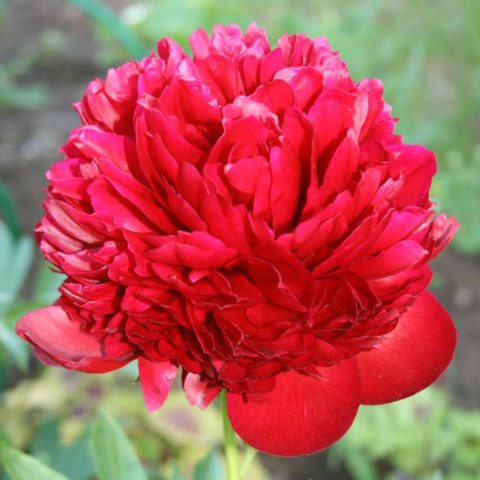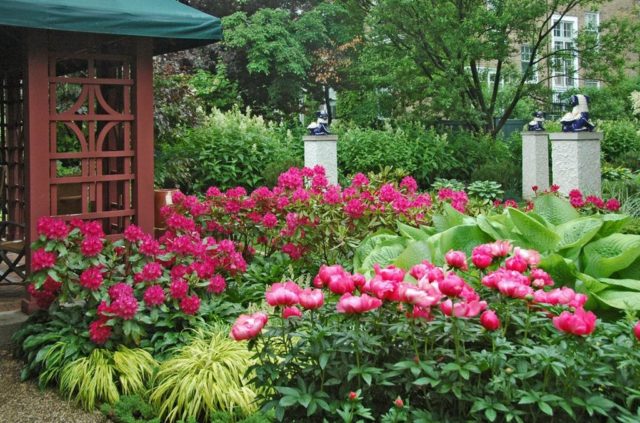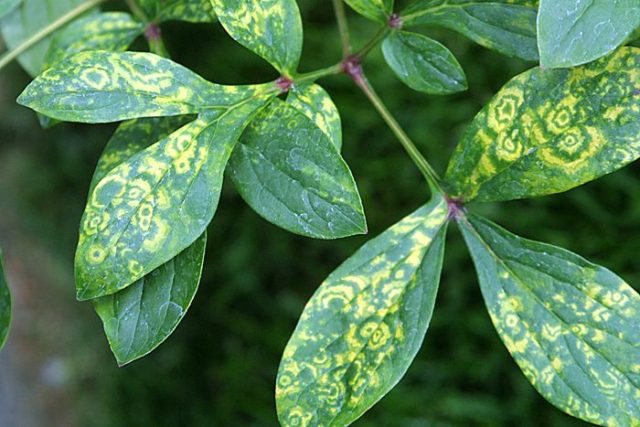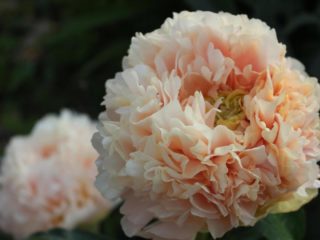Content
Peony Red Spider was developed in the Netherlands. The perennial is known not only for its spectacular appearance, but also for its frost resistance. The plant is used in landscape design.
Description of the Red Spider peony
The variety belongs to the Lactiflora species, which was obtained by breeders in China, from where it spread throughout Europe. Peony Red Spider is sun-loving, prefers garden soils, and is highly frost-resistant: it can withstand temperatures down to -34-40 °C. It is preferable to plant in the Moscow region and most of Russia, as well as in the mountainous regions of Scandinavia.
The shrub is low-growing, reaching a height of no more than 45-70 cm. The leaf blades of the Red Spider variety are large, pinnately dissected, unpaired, and rich green in color. The shrub is compact and does not require the construction of supports to protect the shoots from damage.

The stems of the plant are erect and strong
Features of flowering
The formation of buds lasts May and June. The blossomed flower is 15-20 cm in diameter. The bud is double, single, has a corolla, a calyx with sepals. Petals of unusual shape, double-needle-shaped, are distinguished by a rich, bright crimson hue.First, the flowers bloom in the middle of the bush, and then the side buds appear.

Milky-flowered peonies are known among gardeners for their pleasant aroma.
For successful flowering, the Red Spider variety requires at least 10 hours of daylight, although it can tolerate light partial shade. Buds are formed abundantly when the temperature is + 20-22 °C.
Application in design
To make the flower garden look as harmonious as possible, you should take into account the features of peonies:
- the crop is a perennial, grows in one place for many years, does not like transplanting;
- The bush will grow for the first 1-2 years, only after that it will delight you with abundant flowering;
- the Red Spider peony, like other representatives of this species, is a dominant, so it is not recommended to place it next to other varieties, but it is better to select companions for the plant;
- after the buds fade, a beautiful shrub will remain as a decoration, which will serve as a background for other plants.
The peony is called the Emperor's flower not only for its appearance, but also for its demanding nature: the shrub needs a lot of sun, moisture and nutrients. An unsuccessful neighborhood will lead to the death of one of the plants.
Most gardeners prefer to plant a flower as a tapeworm; it alone can decorate the area.

Planting flowers next to the walls of houses or along paths in the garden is a favorite option among landscape designers.
If there is space, it is allowed to place annuals next to the peony, which will attract attention when the Red Spider flowers fall off.It is recommended to consider crops such as hostas or soft mantle.
When creating tiered plantings, it is necessary to always place the Red Spider peony on the top tier so that it is behind all the vegetation.

When creating circular plantings, the peony should be placed in the center
Along the perimeter of the flower bed with the Red Spider variety, you can plant lilies, irises or bluebells. To create an overall picture, the peony looks good against the background of tall trees and dwarf plants: honeysuckle, barberry.
If you need to decorate the perimeter around the bush, you should pay attention to bergenia, daisies or foxgloves.
Reproduction methods
To propagate a peony bush, use one of the following methods: seeds, tubers, root or stem cuttings.
Propagation by seeds and root cuttings is a very time-consuming method that does not guarantee a positive result. Mature bushes of the Red Spider variety, growing for at least 3-4 years, can be propagated by dividing the bush.

Most gardeners prefer to grow stem cuttings: they cut off a shoot and root it, after which they transfer the young seedling to open ground
Landing rules
The herbaceous Red Spider peony prefers sunny, well-protected areas from the wind.
Good predecessors are green manure or virgin soil. It is not recommended to plant a seedling in an area where shrubs or trees previously grew, which have depleted the soil.
And although the bush is not picky about the soil, it feels most comfortable on loamy soils. The peony will often get sick if it is planted in acidic or swampy soil.
Site preparation consists of three stages: the ground should be dug up, peat and clay should be added. The hole must be at least 70 cm in diameter and 60 cm in depth. It is necessary to form it in such a way that the root system of the bush in it is straightened.

Place drainage at the bottom of the hole, and spread a mixture of sand, peat and humus, and a handful of wood ash on top of it.
Seedlings or saplings should be removed from the pot as carefully as possible, preserving the earthen ball; slight damage to the roots negatively affects the viability of the plant.

The peony seedling along with a lump of earth must be transferred to a hole, filled and compacted, then the plant should be watered abundantly, and the top layer of soil should be mulched.
Aftercare
During the rainy season, the Red Spider peony does not need watering. In hot weather, the bush should be moistened once every 10 days. It is not recommended to neglect watering in May and June, when buds are forming. It is important to moisten the soil in a timely manner at the end of July and August, during this period buds form.
After each watering, the soil under the Red Spider peony must be loosened so that air can flow to the roots.
For 2 years after planting, the young bush does not need fertilizer. In the third year of life, the procedure should be performed 4 times:
- first feeding in spring: 1 tbsp. l.ammonium nitrate is dissolved in 19 liters of water, poured under the peony;
- during the period of bud formation: 0.5 tbsp. l. mix superphosphate, potassium salt and ammonium nitrate and then scatter along the periphery of the bush;
- fertilizing of identical composition is applied during flowering;
- after all the buds have fallen, fertilize the plant one last time, scattering 0.5 tbsp under it. l. superphosphate and potassium salt.
Preparing for winter
Since the Red Spider peony is frost-resistant, it does not need shelter. But most gardeners prefer to protect the shrub. To do this, it is recommended to use spruce branches from coniferous trees, sawdust or peat.

The most common covering method is the use of special fabric.
A mandatory procedure for caring for Red Spider peony in the autumn is pruning. It must be carried out in the last week of October or in the first ten days of November.

The pruning procedure is simple: all shoots must be removed, leaving “stumps” 6-8 cm high
Cut healthy tops can be used as mulch. If the plant has been attacked by pests or diseases during the season, then the shoots must be destroyed.
Pests and diseases
Peony Red Spider has good immunity, but neglect of care weakens the plant, which allows pests and diseases to become active.
Fungal rust spores appear as brown spots on leaf blades. They are capable of infecting neighboring plants, spreading through the air with the wind.

If rust is detected, all modified shoots must be destroyed, and the bush should be sprayed with Bordeaux mixture.
Gray rot appears as a corresponding color coating on the trunk and leaf blades. Most often, the disease becomes active during the rainy season.

To save the Red Spider peony, all affected parts should be removed and the bush itself should be treated with a fungicide.
Diagnosing powdery mildew is simple: a white coating appears on the leaf blades.

To combat powdery mildew, it is necessary to irrigate the bush with a solution of soda ash and laundry soap.
If lightened areas appear on the leaf plates and gradually dry out, then these are signs of a mosaic.

There is no treatment for mosaic, the plant must be destroyed
In addition to diseases, the Red Spider peony is attacked by insects. Most often these are aphids, ants, thrips. To combat them, it is recommended to remove damaged leaves and irrigate the bush itself with an insecticide solution from a spray bottle.
As preventive measures, you should not neglect the rules of care, remove weeds in a timely manner, and thin out the bush.
Conclusion
Red Spider Peony is a beautiful perennial that can decorate any area. It is planted along paths and walls, and looks great in mixborders. The shrub is frost-resistant, undemanding in care, and pleases with large buds in May-June.








